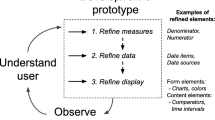Abstract
To better understand physicians’ current and desired feedback experiences on their interactions with patients, this qualitative study applied design thinking methods to facilitate discussions and produce artifacts. Nine primary care physicians and one medical resident participated in a design workshop to understand experiences, needs, and opportunities for design. Thematic analysis found that, 1) Feedback, received in many forms, is important to physicians’ practice and patient well-being, 2) there are concerns about the impact of certain types of feedback, and 3) experience and system-related factors can impact physicians’ workflow and interactions. Tools to improve feedback should take into account these considerations. While residents may desire immediate, direct feedback, concerns about the potential impact on patient care and their current workflow are important.
Access this chapter
Tax calculation will be finalised at checkout
Purchases are for personal use only
Similar content being viewed by others
References
n.d. Stormboard.
Asan, O., Chiou, E., Montague, E.: Quantitative ethnographic study of physician workflow and interactions with electronic health record systems. Int. J. Ind. Ergon. 49, 124–130 (2015). https://doi.org/10.1016/j.ergon.2014.04.004
Asan, O., Kushner, K., Montague, E.: Exploring residents’ interactions with electronic health records in primary care encounters. Fam. Med. 47(9), 722–726 (2015)
Badwan, B., Bothara, R., Latijnhouwers, M., Smithies, A., Sandars, J.: The importance of design thinking in medical education. Med. Teach. 40(4), 425–426 (2018). https://doi.org/10.1080/0142159x.2017.1399203
Baines, R., et al.: The impact of patient feedback on the medical performance of qualified doctors: a systematic review. BMC Med. Educ. 18(1), 173 (2018). https://doi.org/10.1186/s12909-018-1277-0
Farrington, C., Burt, J., Boiko, O., Campbell, J., Roland, M.: Doctors’ engagements with patient experience surveys in primary and secondary care: a qualitative study. Health Expect. 20(3), 385–394 (2017). https://doi.org/10.1111/hex.12465
Faucett, H.A., Lee, M.L., Carter, S.: I should listen more: real-time sensing and feedback of non-verbal communication in video telehealth. Proc. ACM Hum.-Comput. Interact. 1(CSCW), Article 44 (2017). https://doi.org/10.1145/3134679
Gardner, R.L., et al.: Physician stress and burnout: the impact of health information technology. J. Am. Med. Inform. Assoc. 26(2), 106–114 (2019). https://doi.org/10.1093/jamia/ocy145
Gregory, M.E., Russo, E., Singh, H.: Electronic health record alert-related workload as a predictor of burnout in primary care providers. Appl. Clin. Inform. 8(3), 686–697 (2017). https://doi.org/10.4338/ACI-2017-01-RA-0003
Hartzler, A.L., et al.: Real-time feedback on nonverbal clinical communication. Methods Inf. Med. 53(05), 389–405 (2014)
Hewson, M.G., Little, M.L.: Giving feedback in medical education: verification of recommended techniques. J. Gen. Intern. Med. 13(2), 111–116 (1998). https://doi.org/10.1046/j.1525-1497.1998.00027.x
ISO 2019: Human-centred design for interactive systems (ISO 9241–210:2019) in Ergonomics of human-system interaction. https://www.iso.org/obp/ui/#iso:std:iso:9241:-210:ed-2:v1:en
Jackson, J.L., Kay, C., Jackson, W.C., Frank, M.: The quality of written feedback by attendings of internal medicine residents. J. Gen. Intern. Med. 30(7), 973–978 (2015). https://doi.org/10.1007/s11606-015-3237-2
Lamonica, H.M., et al.: Technology-enabled mental health service reform for open arms – veterans and families counselling: participatory design study. JMIR Form. Res. 3(3), e13662 (2019). https://doi.org/10.2196/13662
Miles, M.B., Huberman, A.M., Saldaña, J.: Qualitative Data Analysis : A Methods Sourcebook. SAGE Publications Inc., Thousand Oaks (2014)
Patton, M.Q.: Qualitative Research & Evaluation Methods : Integrating Theory and Practice. SAGE Publications Inc., Thousand Oaks (2015)
Payne, V.L., Hysong, S.J.: Model depicting aspects of audit and feedback that impact physicians’ acceptance of clinical performance feedback. BMC Health Serv. Res. 16(1), 260 (2016). https://doi.org/10.1186/s12913-016-1486-3
Salyers, M.P., et al.: The relationship between professional burnout and quality and safety in healthcare: a meta-analysis. J. Gen. Intern. Med. 32(4), 475–482 (2016). https://doi.org/10.1007/s11606-016-3886-9
Woods, L., Duff, J., Roehrer, E., Walker, K., Cummings, E.: Design of a consumer mobile health app for heart failure: findings from the nurse-led co-design of Care4myHeart. JMIR Nurs. 2(1), e14633 (2019). https://doi.org/10.2196/14633
Author information
Authors and Affiliations
Corresponding author
Editor information
Editors and Affiliations
Rights and permissions
Copyright information
© 2021 Springer Nature Switzerland AG
About this paper
Cite this paper
Loomis, A., Montague, E. (2021). Human-Centered Design Reflections on Providing Feedback to Primary Care Physicians. In: Kurosu, M. (eds) Human-Computer Interaction. Design and User Experience Case Studies. HCII 2021. Lecture Notes in Computer Science(), vol 12764. Springer, Cham. https://doi.org/10.1007/978-3-030-78468-3_8
Download citation
DOI: https://doi.org/10.1007/978-3-030-78468-3_8
Published:
Publisher Name: Springer, Cham
Print ISBN: 978-3-030-78467-6
Online ISBN: 978-3-030-78468-3
eBook Packages: Computer ScienceComputer Science (R0)




